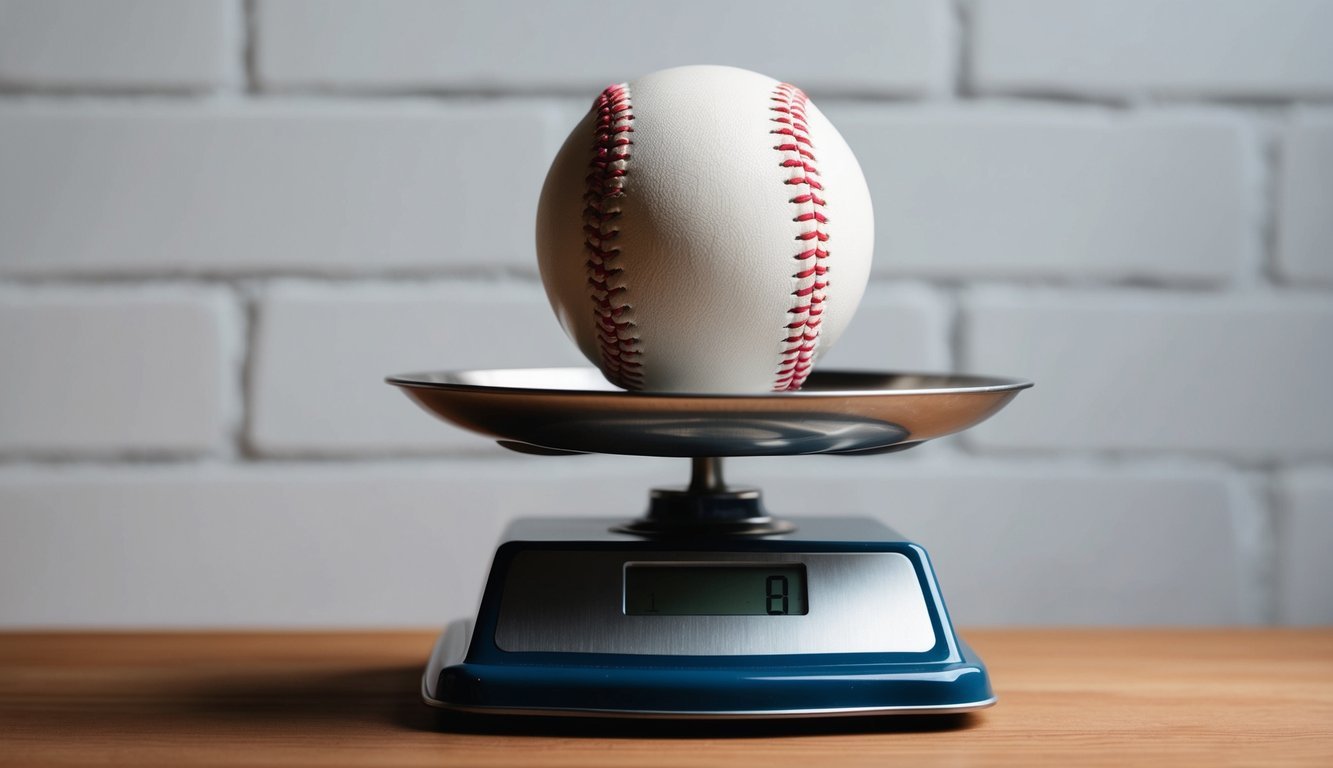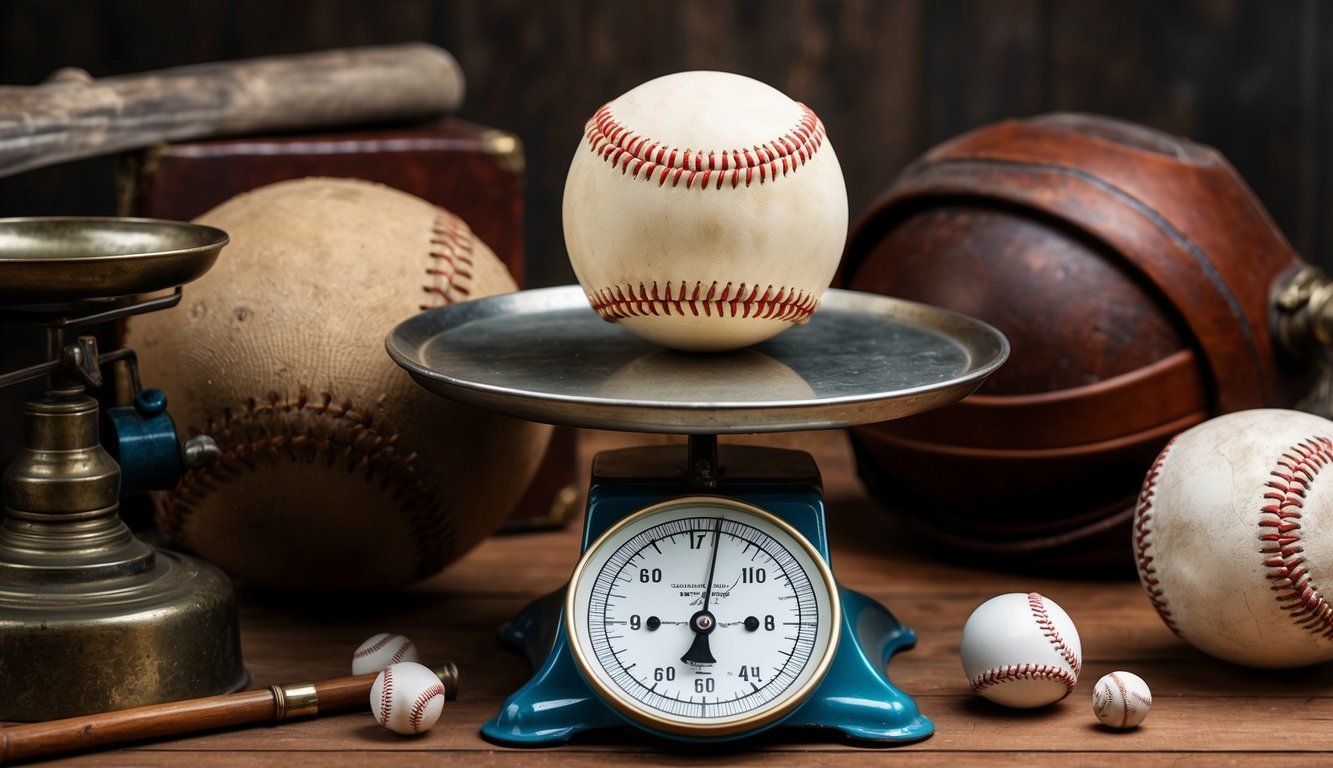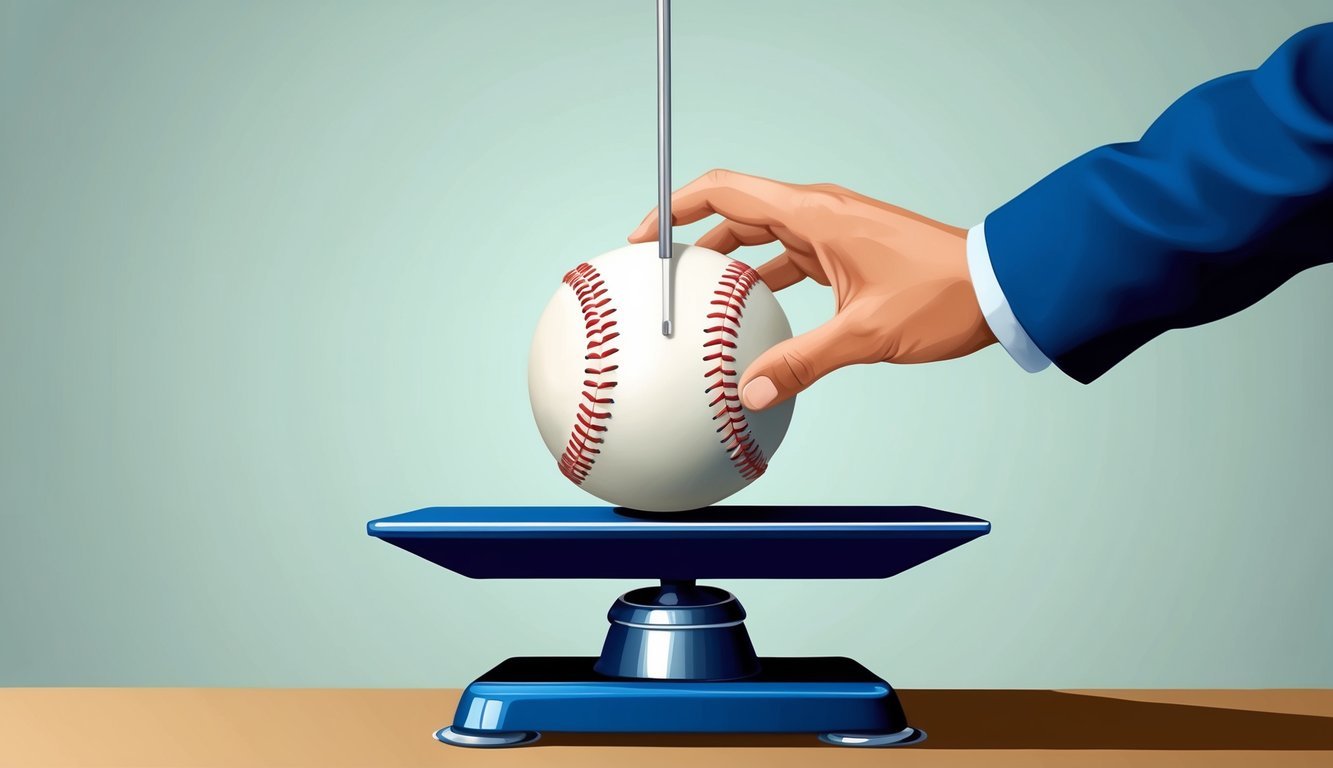Baseball fans often wonder about the precise weight of the ball used in America’s favorite pastime.
This seemingly simple question actually has a fascinating history and science behind it.
A regulation Major League Baseball weighs between 5 and 5.25 ounces (141.75 to 148.83 grams). This standardized weight range ensures consistency in gameplay across all professional baseball matches.
The weight of a baseball plays a crucial role in how it travels through the air and reacts upon contact with the bat.
The construction of a baseball is an intricate process involving multiple layers of materials.
At its core is a cork and rubber center, wrapped tightly with yarn, and covered with two strips of white leather stitched together.
This composition allows for the perfect balance of weight, size, and durability needed for optimal performance on the field.
The Fundamentals of Baseball Weight
A baseball’s weight is carefully regulated to ensure fairness and consistency in the game.
The precise specifications have evolved over time but are now standardized across professional leagues.
Standard Weights Across Leagues
Major League Baseball (MLB) sets the standard for baseball weight.
Official MLB baseballs weigh between 5 and 5.25 ounces (142 to 149 grams).
This weight range applies to all professional leagues in North America.
Little League baseballs are slightly lighter, typically weighing around 4 to 5 ounces.
This adjustment makes it easier for young players to throw and hit the ball.
College and high school leagues generally follow MLB standards, using balls in the 5 to 5.25 ounce range.
Materials and Composition
The weight of a baseball comes from its carefully layered construction.
At its center is a cork core, sometimes mixed with rubber.
This core is wrapped tightly in layers of yarn.
The amount and tension of the yarn affect the ball’s weight and bounce.
A leather cover is stitched over the yarn layers.
The cover’s thickness and the number of stitches (typically 108) contribute to the final weight.
Size and Weight Specifications
MLB baseballs must meet strict size requirements in addition to weight.
The circumference should measure between 9 and 9.25 inches.
This translates to a diameter of about 2.86 to 2.94 inches.
The size and weight specifications work together to create a ball with consistent flight properties.
Humidity and temperature can cause slight variations in weight.
Baseballs are often stored in climate-controlled environments to maintain consistency.
Manufacturers use precise techniques to ensure each ball falls within the acceptable weight range, typically aiming for the middle at about 5.125 ounces.
Construction and Design

A baseball’s intricate construction involves specific materials and processes to achieve its standardized weight and performance characteristics.
The ball’s design has evolved over time to meet official regulations while maintaining consistent play.
Core Materials
At the heart of every baseball lies a small sphere of cork or rubber.
This core provides the ball with its bounce and resilience.
Cork cores are typically used in professional-grade baseballs, while rubber cores are more common in recreational and practice balls.
The core is then wrapped tightly with layers of wool yarn.
This wool winding gives the baseball its shape and helps absorb shock upon impact.
Different grades of wool may be used, with finer wool closer to the core and coarser wool near the outer layers.
Outer Materials and Stitches
The outer cover of a baseball is made from either cowhide or horsehide leather.
Cowhide is more commonly used today due to its availability and consistent quality.
The leather is carefully cut into two figure-8 shaped pieces.
These leather pieces are then stitched together with 108 double stitches using red cotton thread.
The raised seams not only hold the cover in place but also affect the ball’s aerodynamics during pitches and hits.
Manufacturing Process
Baseball manufacturing is a meticulous process that combines both machine work and hand craftsmanship.
Companies like Rawlings, the official supplier for Major League Baseball, have refined this process over many years.
The core is first machine-wound with yarn.
Then, skilled workers apply the leather cover and perform the crucial stitching by hand.
This handcrafting ensures each ball meets exact specifications.
After stitching, the balls undergo a rolling process to smooth out seams.
They are then inspected for weight, size, and appearance before being approved for use in games.
Historical Evolution

The weight of a baseball has undergone significant changes since the sport’s inception.
These changes reflect advancements in manufacturing and shifts in gameplay preferences.
From Dead Ball to Live Ball
In the early days of baseball, known as the Dead Ball Era (1900-1920), balls varied in weight and composition.
They often became misshapen during play, making hitting more challenging.
Pitchers could easily manipulate these softer balls, leading to low-scoring games.
The Live Ball Era began in 1920 when MLB introduced a standardized ball.
This new ball featured a cork center and tighter winding, making it livelier off the bat.
The weight was set between 5 and 5.25 ounces, a range that remains standard today.
This change dramatically increased offensive production, ushering in an exciting new era of baseball.
Impact of Wars on Baseball Materials
World War II significantly affected baseball manufacturing.
Rubber shortages led to the use of balata, a rubber-like substance, for the ball’s core.
This temporary change altered the ball’s performance.
After the war, manufacturers returned to using rubber.
However, the experience sparked interest in exploring new materials for improved durability and consistency.
Innovations in Manufacturing
A.G. Spalding pioneered early baseball manufacturing techniques.
In 1974, a major innovation occurred with the introduction of the cushioned cork center.
This design enhanced the ball’s resiliency and durability.
Modern baseballs feature a cork core wrapped in layers of wool and poly/cotton yarn.
The outer cover is made of cowhide, precisely stitched to meet MLB standards.
Advanced manufacturing processes ensure consistent weight and performance across all baseballs used in professional play.
Playing Dynamics and Performance

The weight of a baseball significantly impacts various aspects of gameplay.
It influences pitching mechanics, hitting power, and ball flight characteristics, shaping the overall dynamics of the sport.
Additionally, a heavier baseball can lead to increased strain on pitchers’ arms, affecting their stamina and performance over the course of a game.
As players strive for optimal performance, mastering pitching techniques becomes crucial to adapting to different weights and maintaining effective control.
Ultimately, the interplay between a baseball’s weight and the players’ skills can define the outcome of critical moments during a game.
Influence on Pitching and Hitting
A baseball’s weight affects both pitchers and batters.
For pitchers, the 5 to 5.25 ounce ball allows for optimal control and velocity.
Heavier balls might reduce pitch speed, while lighter ones could lead to erratic movement.
Batters must adjust their swing timing and power based on the ball’s weight.
The standard weight enables consistent exit velocities and distances when hit solidly.
Grip is crucial for pitchers.
The ball’s weight contributes to how securely they can hold and release it, affecting pitch accuracy and movement.
The Role of Weight in Baseball Trajectory
Ball weight plays a key role in determining trajectory.
A regulation baseball’s mass helps achieve the right balance between distance and control.
Heavier balls tend to travel shorter distances due to increased air resistance.
Lighter balls might fly further but are more susceptible to wind effects.
The 5 to 5.25 ounce range allows for optimal home run potential without compromising fairness between offense and defense.
Weight also influences how the ball responds to spin.
Pitchers can manipulate this to create movement on pitches like curveballs and sliders.
Aerodynamics and Ball Behavior
A baseball’s weight interacts with its stitches and surface to create complex aerodynamic effects.
This interaction influences drag and lift forces during flight.
The standard weight ensures consistent behavior in various weather conditions.
It helps maintain the delicate balance between pitching dominance and hitting success.
Spin rate, closely tied to ball weight, affects pitch movement and carry distance on hit balls.
Pitchers leverage this to create deceptive trajectories.
Ball weight impacts how it reacts upon contact with the bat.
It influences exit velocity and launch angle, key factors in determining hit outcomes.
Regulations and Consistency

Baseball relies on precise standards to ensure fair and consistent gameplay.
These regulations cover everything from the ball’s size and weight to how it’s used during official games.
MLB and League Standards
Major League Baseball (MLB) maintains strict rules for baseballs used in official games.
The MLB rulebook specifies that a regulation baseball must weigh between 5 and 5¼ ounces (142 to 149 grams).
Its circumference should measure 9 to 9¼ inches, with a diameter of 2⅞ to 3 inches.
These standards aren’t just for the big leagues.
Many affiliated and youth leagues adopt similar guidelines to promote consistency across different levels of play.
The tight weight range helps pitchers and batters perform consistently, as even small variations can affect a ball’s flight path.
Equipment Control and Fair Play
Standardized baseballs are crucial for fair competition.
Umpires inspect the balls before each game to ensure they meet regulations.
This process helps prevent any unfair advantages that could arise from using non-standard equipment.
Teams can’t simply bring their own baseballs to use.
The home team provides game balls, which are carefully controlled and monitored.
This system helps maintain the integrity of the sport and ensures that all players compete on an even playing field.
Consistency in baseball manufacturing also contributes to player safety.
A properly weighted ball behaves predictably, allowing fielders to react appropriately when catching or fielding.
